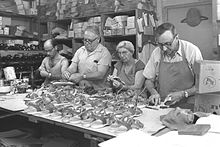Biblical sandals
Biblical sandals are a type of sandal that is characterized by a flat heel and a wide cross strap above the toe. Antique footwear was not the model for these sandals, insofar as it is an invented tradition . The creation of the sandals is closely linked to the Second Aliyah , an immigration movement of Eastern European Jews to Palestine, then a British mandate. They developed into a typical Israeli product.
Beginnings in the kibbutz movement
The shape of the Biblical Sandals came about by chance when two members of the Kibbutz Beit HaShita who were involved in shoe repair also made new shoes.
In the 1930s, this footwear matched the ideals of the kibbutz movement in several ways : it stood for the meager life in the country, it was affordable for everyone, therefore democratic, it was gender-neutral and durable. It was suitable for work in agriculture, but also for the excursions that were propagated by the Jediat ha-Aretz movement as a means of settling as immigrants in Eretz Israel . Taking off European shoes and putting on these sandals could be imagined as shedding the Diaspora existence. The name for this footwear was "Chugist sandals"; older members of a socialist youth movement were referred to as Chugists (too Hebrew חוג chug "circle, circle, group") who had a uniform style of clothing.
Connection to the Bible and ancient Judaism
Since the late 1930s and then increasingly in the 1950s and 1960s, this type of sandal lost its strong connection to the kibbutz movement and was interpreted as historical Jewish footwear. Now he was given the name " Tanach sandals" ( Hebrew סנדלים תנ"כיים sandalim tanachim ). To associate the type of sandal with a wide cross strap over the forefoot with the protagonists of the Hebrew Bible (Tanach) is incorrect: parallels from Egypt and Mesopotamia make the toe sandal more likely for the Iron Age in Palestine.
During the archaeological exploration of the caves in the Judean Desert under the direction of Yigael Yadin , properties of the Babatha , a Jewish woman who lived at the time of the Bar Kochba uprising in the 2nd century AD, were discovered. The shoe company Nimrod (Tel Aviv) produced a sandal based on the ancient Babatha sandal in 1965 and advertised the similarity between the antique shoe and the sandals "worn by the fashion-conscious young Israeli Sabra ". The Nimrod company varied different types of sandals: the Chugist sandal, antique toe sandals and other sandal traditions, e.g. B. from Mexico.
Newer development
In the 1980s, the German company Birkenstock began exporting shoes to Israel. Their success motivated the Israeli shoe company Teva Naot from Kibbutz Neot Mordechai in Upper Galilee to develop anatomically shaped sandals; she acquired the Birkenstock patent. The Teva sandals, which in contrast to classic biblical sandals have a flexible sole, became popular in Israel and supplanted the Biblical sandals as the trademark of the Sabra. On the other hand, the anatomical sandals by Teva Naot, as well as the sandals by Nimrod and the Shoresh trekking sandals by Source Vagabond Systems (Haifa) are also referred to as types of biblical sandals.
See also
literature
- Orna Ben-Meir: The Israeli Shoe: Biblical Sandals and Native Israeli Identity . In: Edna Nahshon (Ed.): Jews and Shoes , Berg Publishers, 2008. ISBN 9781847880499 . Pp. 77-89.
- Eric Silverman: A Cultural History of Jewish Dress . Bloomsbury, London et al. 2013, ISBN 978-1-84520-513-3 .
- Yonatan Mendel, Ronald Ranta: From the Arab Other to the Israeli Self: Palestinian Culture in the Making of Israeli National Identity . Routledge, London / New York 2016. ISBN 978-1-472-44935-1 .
- Tamar El Or: The Soul of the Biblical Sandal: On Anthropology and Style . In: American Anthropologist Vol. 114, 3/2012, pp. 433-445. ( PDF )
Individual evidence
- ↑ Eric Silverman: A Cultural History of Jewish Dress , London et al. 2013, p. 21.
- ^ Oz Almog: The Sabra: The Creation of the New Jew , London 2000, p. 213.
- ↑ Yonatan Mendel, Ronald Ranta: From the Arab Other to the Israeli Self: Palestinian Culture in the Making of Israeli National Identity , London / New York 2016, p. 66 f.
- ↑ Eric Silverman: A Cultural History of Jewish Dress , London et al. 2013, p. 22.
- ^ Tamar El Or: The Soul of the Biblical Sandal: On Anthropology and Style , 2012, p. 436.
- ^ Tamar El Or: The Soul of the Biblical Sandal: On Anthropology and Style , 2012, p. 434.
- ^ Oz Almog: Secular fashion in Israel . In: Shoshana-Rose Marzel, Guy D. Stiebel (Ed.): Dress and Ideology: Fashioning Identity from Antiquity to the Present . Bloomsbury, London / New York 2015, pp. 19–36, here p. 27.
- ↑ Yonatan Mendel, Ronald Ranta: From the Arab Other to the Israeli Self: Palestinian Culture in the Making of Israeli National Identity , London / New York 2016, p. 67.


